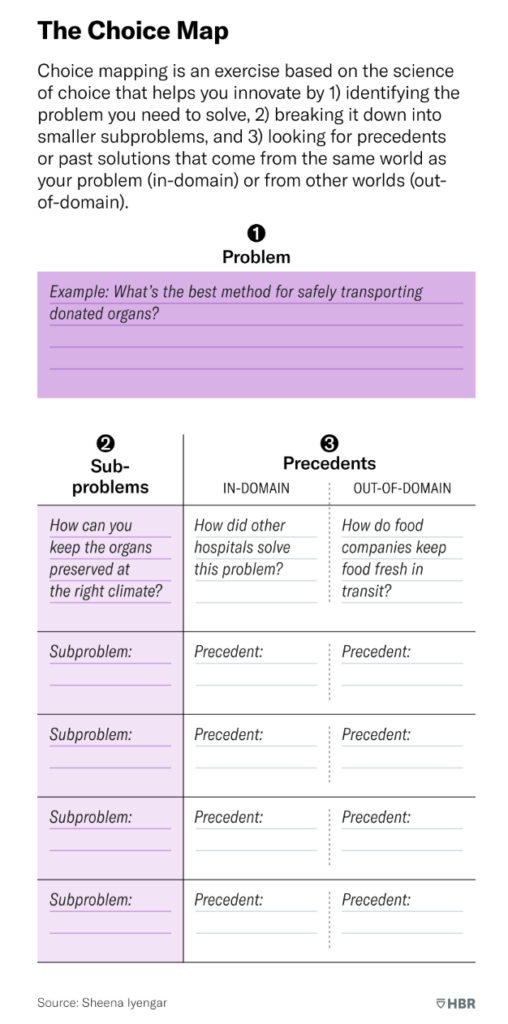6 Ways to Craft Innovative Business Ideas That Can Transform Your Future
South Africa is a country built on innovation, but for entrepreneurs looking to make a mark in their industry, knowing how to come up with innovative business ideas is a common stumbling block.
Steve Jobs once said that “innovation distinguishes between a leader and a follower”, but in a country filled with small-to-medium enterprises (SMEs), it goes much deeper than that.
A lack of innovation is a major reason why over 70% of South African SMEs fail within five to seven years of their launch, according to research from Emerald, an online academic platform.
Yet, if you’re seeking that creative spark to ignite your entrepreneurship journey, you don’t need magic powers to find that next great business idea.
Innovative thinking comes from a process that any small business owner can replicate, not just the world’s finest minds. We can even integrate this process into a tangible business plan by weaving it into its customer research and product testing stages.
To help us do this, we can tap into the expertise of some of the world’s leading business minds to uncover the secret of how to come up with innovative ideas that lead to success.
Read on to find out more.
Struggling for time to come up with innovative business ideas? Open a Lula account today and find out how our all-in-one financial management platform frees up more time (and money) for creative thinking to fuel your business’s growth.
6 tips on how to come up with innovative business ideas
The process of innovative business thinking can start at any point and for any type of business, whether you’re a social media influencer on Instagram or LinkedIn, a real estate investor, or an Amazon store owner.
Yet, rather than looking to the stars for inspiration, we can follow certain steps that leading business figures turn to when seeking the next big thing.
Here are six tried and tested ways to answer the question of how to come up with innovative business ideas:
1. Understand your target customer base
History’s greatest business ideas were sprung out of empathy for the consumer and what she or he needs.
Yet, this isn’t always immediately obvious, which is why any top business conducts in-depth market research to build a clear picture of its target customer. Marketers refer to this as a ‘buyer persona’, and it influences every aspect of a marketing campaign, from product design to SEO-based content writing.
The most effective buyer personas are surprisingly detailed. Going far beyond simple likes and dislikes, it might include their job, their favourite TV program, or even their pet’s name.
Such details may appear trivial, but they help us to really dig into the psyche of our target audience and connect with them on a deeper level.
This emotional connection often leads to more innovative ideas because it’s rooted in a genuine understanding of what people truly need and care about.
2. Be selective in where you focus your effort and resources
We only get a limited amount of time and resources, but the most successful business minds know exactly where to focus them.
For many would-be innovators, the temptation to spread their efforts over a wide area is very strong. After all, it’s human nature to keep our options open.
Yet, this leads to clouded thinking as we juggle various options simultaneously.
So, how do you know where to channel your focus? The answer lies in identifying opportunities that tick two vital boxes: those that serve the needs of the target customer we just mentioned and those that hold the most potential for your type of business.
Thomas McKinnon, COO of financial platform Lula, knows what it takes for a new business to thrive in South Africa’s demanding economic climate.
His extensive background in product development and startup growth has helped him and his team work on how to come up with innovative business ideas, like Lula’s new cash flow solution Lulaflow.
Lulaflow solved a pain point that many South African SMEs had in common: outdated methods of tracking cash flow that were hindering business progress.
“There were literally thousands of other projects or features we could’ve taken on,” he says, “but 10/10 customers were flagging these issues to us and letting us know how unsatisfied they were with the old way of tracking cash flow. So we were able to focus on this innovation and cut out a lot of the noise.”
Being selective meant we were able to focus on innovation and cut out a lot of the noise
Thomas McKinnon COO
Second, Lulaflow has served an acute need in the South African business sector by helping many SMEs improve cash circulation, secure survival, and safeguard jobs during turbulent economic times.
Homing in on one or two core opportunities in this way is something every entrepreneur can do. Not only does it help to crystallise our focus, but it also reduces decision-making complexity, allowing us to better allocate our resources.
3. Focus on customer’s needs, then work backwards
Many good business ideas fail because of back-to-front thinking. Entrepreneurs get seduced by new products that sound amazing in their own minds but fail to consider the very people they’re selling to.
Google Glass is a recent famous example: a new technology product pushed by the company’s owners that went down like a lead balloon with the general public due to inaccurate pricing and a misreading of demand.
66% of US consumers were “very unlikely” to buy Google Glass at 50% of its original retail price
Source: Google Consumer Survey (Via Glass Almanac)
Instead, the high-quality new business ideas come from switching this thinking around to start with the customer. Thomas McKinnon refers to this as “working backwards from customers’ unmet needs”.
Instead of creating a product and hoping that the people will come, we should understand what our target market wants and build our startup ideas around that.
Thomas refers to the “jobs-to-be-done framework” as a means of achieving this. This focuses on specific tasks or “jobs” people are trying to accomplish, emphasising their functional and emotional needs.
Out of this well should spring the innovative ideas that will not only impress us but cater to a vital customer necessity, too.
By striking a balance between profitability and customer-centricity,” says Thomas, “You can create meaningful solutions that drive both success and revenue.
4. Compare business ideas to existing products and how they can improve them
The outside world is probably our best source of inspiration when it comes to new business ideas.
We can use existing products to bounce our ideas off, including asking ourselves whether our ideas can improve or simplify them.
Customer feedback is one valuable route to finding this out. Complaints often reveal areas for improvement and insights into what the market demands. We can use them to refine ideas or hit a market segment that competitors are missing.
Consider an e-commerce start-up selling gym equipment. They see that many online stores already sell fitness gear, but not many offer bundle purchases at a discount, something that reviewers have also commented on.
An example of a profitable business model might include bundle customisation that allows customers to use specific weights, resistance bands, and other accessories in one package. There could also be a subscription service offering flexible equipment leasing.
Far from being threats to your own business, competitors can inspire us to create unique and customer-friendly solutions that don’t yet exist on the market.
5. Use “Choice Maps” to guide you to an innovative breakthrough
The Harvard Business Review (HBR) is one of the world’s leading business publications, and its thought leaders champion “Choice Mapping” as a powerful strategy when tapping into our creative wells.
Choice Maps work by breaking down complex problems into more manageable subproblems, working out the solution to these, and then combining these answers to find a unique solution.
A famous user of this method was carmaker Henry Ford. In 1899, he wanted to know how to make cars more affordable for the average person, but he knew this was too complex.
So, he broke it down into smaller questions:
- How do I reduce the cost of labour?
- How do I reduce production time?
- How do I reduce the cost of materials?
Ford found the answers to these in things that already existed: a new type of assembly line, moving workers along the line instead of products, and even a special type of black paint.
We can’t expect to replicate Ford’s achievements, but we can replicate his ideas by mapping out a choice map like the one below.
HBR uses the term ‘precedents’ to refer to previous solutions and divides them according to whether they exist in our industry or outside it (“in-domain” and “out-domain”).

An example of HBR’s Choice Map for clarifying innovative thinking
Source: HBR
By pooling all of this information together, we get a clear overview of our situation and can start mixing and matching solutions.
Like a mix of brainstorming and piecing together a jigsaw puzzle, Choice Maps can lead us to the spark that fires our next business breakthrough.
6. Test and iterate
We can speculate all we want, but we only know if an idea is truly innovative until we put it into practice.
Then, we’re in a position to tweak something that’s only at, say, 50% of its potential into something truly special.
So, how do we do this? Well, Thomas McKinnon stresses that there’s no need to overcomplicate things.
More specifically, engaging with customers via questionnaires and focus groups is the best way to find out what they think of an idea and to get fresh perspectives.
We can also experiment with different pricing points to see where the sweet spot of customer satisfaction and profitability lies.
Businesses that can integrate these interactions into their idea development cycle are the ones that know how to come up with innovative business ideas that keep their customers happy – and drive long-term growth.
Innovative business ideas are vital, but you need the resources to think of them. Open a Lula account today and take advantage of its cash flow management tools and Revolving Capital Facility to free up more time and money to grow your business.







